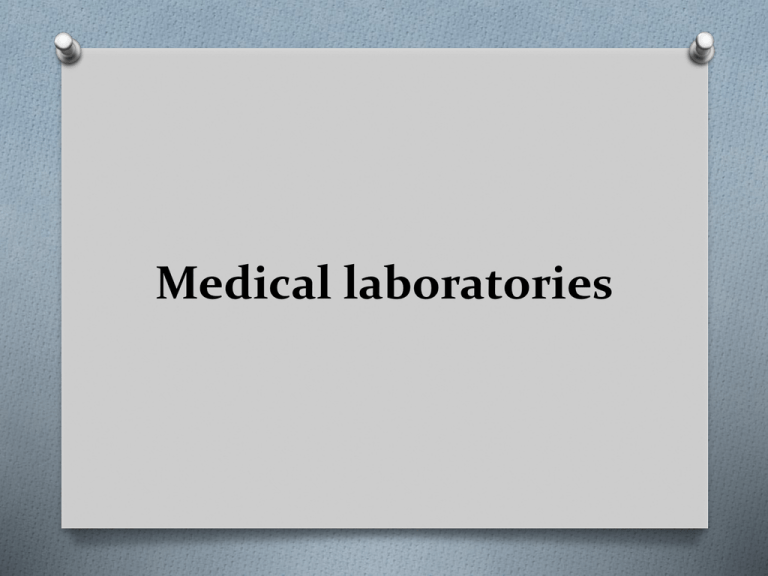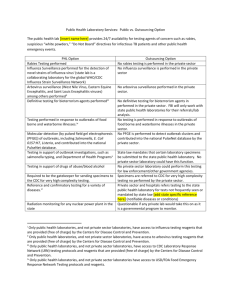LABORATORIES Types of laboratories and laboratory tests
advertisement

Medical laboratories A laboratory is a facility that provides controlled conditions in which scientific or technological research, experiments, and measurement may be performed A medical laboratory or clinical laboratory is a laboratory where tests are done on clinical specimens in order to get information about the health of a patient as pertaining to the diagnosis, treatment, and prevention of disease. Role of medical laboratory services O The medical laboratory services play a essential role in Treating patients and monitoring their response to treatment 2. Monitoring the development and spread of infectious and dangerous pathogens (disease causing organisms), 3. Deciding effective control measures against major prevalent disease, 4. Deciding health priorities and allocating resources. 1. Without reliable laboratory services: O The source of a disease may not be identified correctly. O Patients are less likely to receive the best possible care. O Resistance to essential drugs may develop and continue to spread. O Epidemic diseases may not be identified on time and with confidence. O What is medical laboratory science? O Medical laboratory science is the use of clinical laboratory tests to detect, diagnose, monitor and treat disease. O Blood, tissue and body fluids can be chemically analyzed and examined for foreign organisms and abnormalities. O This information is then used by the medical team to make decisions regarding a patient's medical care. 85% of all medical decisions are based on the results of clinical laboratory testing. Laboratory tests What are lab tests? Laboratory tests are medical procedures that involve testing samples of blood, urine, or other tissues or substances in the body. Why does your doctor use lab tests? Your doctor uses laboratory tests to help: O identify changes in your health condition before any symptoms occur diagnose a disease or condition before you have symptoms O plan your treatment for a disease or condition O evaluate your response to a treatment, or O monitor the course of a disease over time Laboratory tests How are lab tests analyzed? Laboratories perform tests on the sample to see if it reacts to different substances. What do lab tests show? Lab tests show whether or not your results fall within normal ranges. Normal test values are usually given as a range, rather than as a specific number, because normal values vary from person to person. Types of laboratories In many countries, there are two main types of labs O Hospital laboratory are attached to a hospital, and perform tests on patients. O Private (or community) laboratory receive samples from general physician, insurance companies, clinical research sites and other health clinics for analysis. O A lot of samples are sent between different labs for uncommon tests. It is more cost effective if a particular laboratory specializes in a rare test, receiving specimens (and money) from other labs, while sending away tests it cannot do. Lab department In many countries there are mainly three types of Medical Laboratories as per the types of investigations carried out. 1. Clinical Pathology: Haematology, Histopathology, Cytology, Routine Pathology 2. Clinical Microbiology: Bacteriology, Virology, Mycology, Parasitology, Immunology, Serology. 3. Clinical Biochemistry: Biochemical analysis, Hormonal assays etc. Blood Banks:- Blood bank is a separate body. Its laboratory need Microbiological analysis for infectious diseases that may be found in blood. Pathology to observe Blood grouping, Haematology & cross matching reactions.. Molecular diagnostic lab or cytogenetics and molecular biology lab is the latest addition to the three types of medical laboratories listed above in many countries. What is a medical laboratory scientist? Medical laboratory scientists (formerly known as medical technologists) are laboratory professionals who are part of the medical team of specialists who work together to determine the presence, extent or absence of disease. They perform a full range of laboratory tests from simple blood screens to more complex tests to detect diseases like cancer, coronary artery disease and diabetes Role of medical laboratory technologist Some of the major roles of medical laboratory technologist are to: 1. Carry out routine and advanced laboratory tests using standard laboratory methods 2. Apply problem-solving strategies to administrative, technical and research problems 3. Conduct community – based researches in collaboration with other categories of health professionals; 4. Provide professional consultancy on matters related to the establishment, renovation, upgrading and reorganization of medical laboratories of intermediate levels. Lab organization O Organization: - is a system, an orderly structure, putting things together into a working order, and making arrangements for undertakings that involve cooperations. The emphasis is on arrangements that enable peoples working together and accomplishing common objectives in an efficient, planned and economic manner. O In a single medical laboratory at least there are two interlocking components of organizations. These are laboratory head and other staff having their own duties and responsibilities. Professional code of conduct and ethics O Place the well - being and service of the sick above your own O O O O O O interests. Be loyal to your medical laboratory profession by maintaining high standards of work and by improving your professional skills and knowledge. Work scientifically and with complete honesty., Do not misuse your professional skills or knowledge for personal gain. Never take any thing from your place of work that does not belong to you. Do not disclose to a patient or any unauthorized person the results of your investigation. Treat your results and your patient’s information with strict confidentiality. Professional code of conduct and ethics O Respect colleagues and work in harmony. O Be sympathetic and considerate to the sick and their O O O O O relatives. Promote health care and the prevention and control of disease. Follow safety precautions and know how to apply first aid. Do not consume alcohol or any other abusive substances during working hours or when on emergency standby. Use equipment and laboratory wares correctly and with care. Do not waste reagents or other laboratory supplies. Laboratory policies O Laboratory policies are those decisions, which are taken in consultation with other medical staff to enable a laboratory to operate reliably and effectively in harmony with other departments. O These polices usually cover: 1. 2. 3. Laboratory hour and emergency work Collection of laboratory specimen Range of tests to be performed which depend on: O The number of staff available; O The availability of material resources; O The types of health institutions (hospital or health center). 4. Workload capacity of a laboratory which depends on O The number of staff and their level of training. O The size of the laboratory O The availability of laboratory facilities. Structure of medical laboratory services O A laboratory service network consists of: O Community based primary health care laboratory O District hospital laboratory O Regional hospital laboratory O Central and public health laboratory Community based primary health care laboratory Duties O To support primary health care in investigating, controlling and preventing major diseases in the country. O Promoting health care by integrated health education O Collect and refer specimens for testing to the district laboratory. O Main activities are to: O Investigate by referral or testing on site, important diseases and health problems affecting the local community. Such investigations usually include bacterial diseases, parasitic diseases and other causes of illness. O Assist health care worker in deciding the severity of a patient’s conditions. O Notify the district hospital at an early stage of any O O O O laboratory results of public health importance and send specimens for confirmatory tests. Screen pregnant women for anemia, proteinuria, malaria, and refer serum for antibody testing. Promote health cares and assists in community health education Keep records, which can be used by health authorities in health planning and for epidemiological purposes. Send an informative monthly report to the district hospital laboratory. District hospital laboratory Duties: O In addition to the works stated above, these laboratories have an important role in supervising the work of the peripheral community based laboratories, testing referred specimens, and performing a range of tests compatible with the work of district hospital Main activities are to: O Perform a range of tests relevant to the medical, surgical, and public health activities of the district hospital. O Support the work of the community-based laboratories by testing referred specimens, providing reagents, controls, standards, specimen containers, and other essential laboratory supplies. O And also visit each primary health care laboratory in their area to inspect and discuss the investigations being performed and, comment on their quality assurance system, safety procedures, as well as the status of equipment maintenance. O Refer specimens to the regional laboratory for test (s) that cannot be performed in district laboratory. O Notify the regional laboratory of any result of public health importance and to send specimens for confirmatory tests. O Participate in the external quality assurance program organized by the regional laboratory. O Prepare and send periodical reports to the regional laboratory. Regional hospital laboratory Duties O In addition to the duties done at the two above lower levels, the regional laboratory assists and supervises the district laboratories. It analyses referred specimens and performs a range of specialized and other tests as required by the work of the regional hospital. Main activities are to O Operate a regional blood transfusion center; O Prepare reagents, controls, standard solutions and O O O O others as found necessary; Investigate epidemics and perform tests of public health importance in the region; Supervise and support the work of district laboratories; Send specimens that require special investigation to the central and public health laboratory; Prepare periodical reports and send to the central and public health laboratory. Central and public health laboratory O The central and public health laboratory is responsible for planning, advising and overall coordinating of medical laboratory services in the region. Main activities are to: O Formulate a professional code of conduct to medical laboratory personnel. O Perform a range of special tests not normally undertaken in the regional laboratories such as viral, histopathological, cytological, immunological, forensic and genetic investigations. O Carry out appropriate research of importance in order to ease public health problems. O Evaluate new technologies and standardize techniques. O Purchase supplies and equipments for the national O O O O laboratory service and organize an efficient system of requisition, distribution, and maintenance of equipment. Communicate and collaborate with International organizations in promoting laboratory standards. Organize laboratory-teaching seminars and prepare training manuals for the different laboratory-training programmes. Support the work of the regional hospital laboratories. Organize refreshment training and seminars/ workshops for district and primary health care laboratory personnel. O Prepare training manuals for the different laboratory training programmes. O Participate in the prompt laboratory investigation of epidemics and outbreaks of serious illness among communities. Laboratory informatics Laboratories today are held together by a system of software programs and computers that exchange data about patients, test requests, and test results known as a Laboratory Information System or LIS. This system enables hospitals and labs to order the correct test requests for each patient, keep track of individual patient or specimen histories, and help guarantee a better quality of results as well as printing hard copies of the results for patient charts and doctors to check.






